How to Identify and Cook Honey Mushrooms
December 27, 2010 | Updated January 15, 2024
As an Amazon Associate I earn from qualifying purchases.
Honey mushroom is a generic term for a wide complex of wild mushrooms in the Armillaria family, usually A. mellea. Yes, honey mushrooms are edible, with a few caveats. Here’s how to identify, harvest, cook and preserve them.
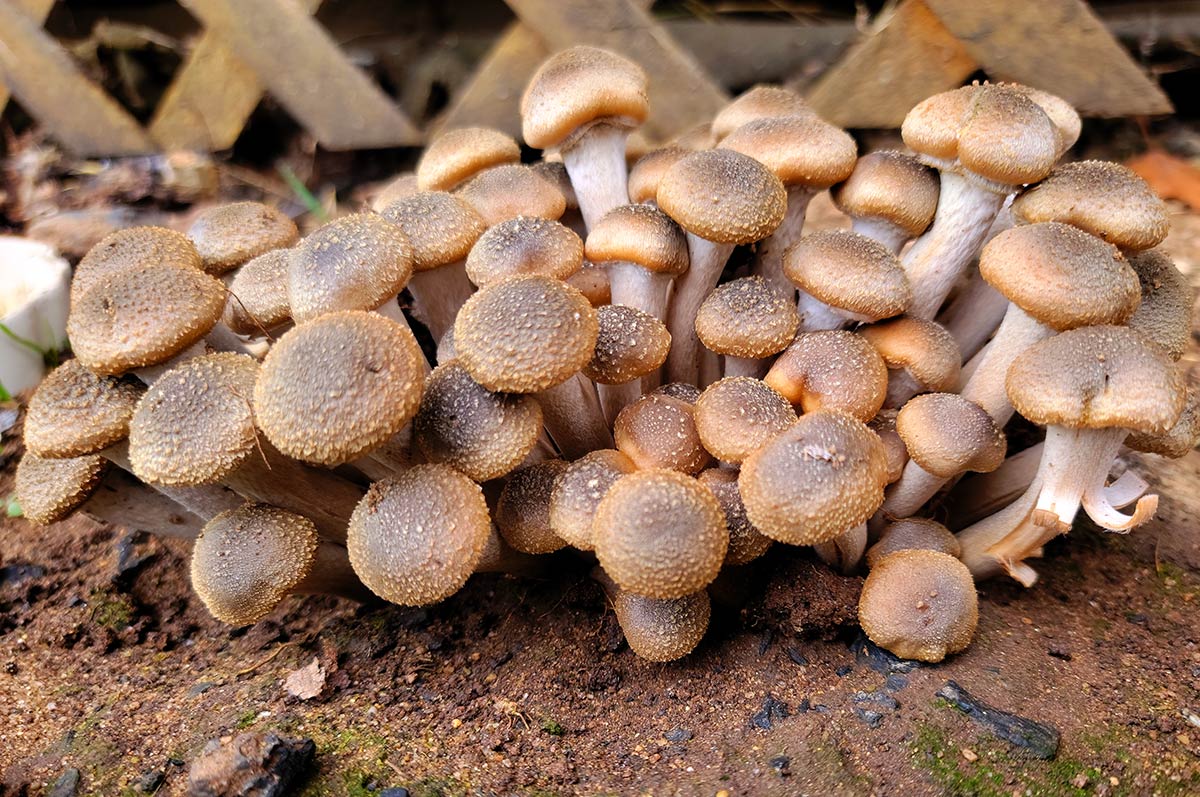
See these? These are primo honey mushrooms. Regardless of species, you want to pick a honey mushroom young, like real young. This patch is in my yard, and it emerged maybe four or five days before I took this picture.
Timing matters with honey mushrooms, although they are still kinda-sorta edible when they get old. More on that in a moment.
Habitat and Range
Honey mushrooms are a circumboreal species, usually found in temperate places, meaning not the tropics. Imagine a ring starting in the boreal forest and extending down into the American South, Europe, and Russia, as well as China.
Mostly you will find them north of a line running from about Fresno, California to about Charlotte, North Carolina, but a few species, like the ringless honey, can be found as far south as Florida.
They are a decomposing mushroom that eats wood and causes “white rot.” If you have it in your yard, as I do, good luck getting rid of it. Killing a honey mushroom is notoriously difficult.
Look at the base of trees, around stumps, and around piles of fallen logs. Honey mushrooms are always in a cluster.
You will find honey mushrooms when the weather is cool and damp. I’ve gathered them in Virginia as early as September, and as late as January here in Sacramento. I’ve never seen them in spring.
Identifying a Honey Mushroom
You want to be very sure about what variety of mushroom you have before you go eating it. This is always good policy, but there are a few poisonous mushrooms that bear a passing resemblance to a honey mushroom, notably the sulfur tuft and the various pholiota species.
You use a “key” to identify a honey mushroom. I’ll walk you through it.
I highly recommend buying a book like David Arora’s Mushrooms Demystified, which contains long “keys” consisting of scores of “if-then” statements. For example, if the mushroom has a ring on the stalk, go to No. 12. If not, go to No. 18, and so on. You start with guidebook pictures to get you in the ballpark, then move on to the more detailed key to confirm your guess.
This is absolutely necessary when you are trying to see if a mushroom that is new to you will taste good, be boring — or will dissolve your liver. Beware of the mycological siren song that traps many a mushroom hunter: It is a common — and potentially lethal — mistake to make a square peg fit into a round hole, mentally downplaying one aspect of a mushroom so it can fit into the edible hole you want it to be in. Dangerous.
Let’s take a closer look at the honey mushroom.
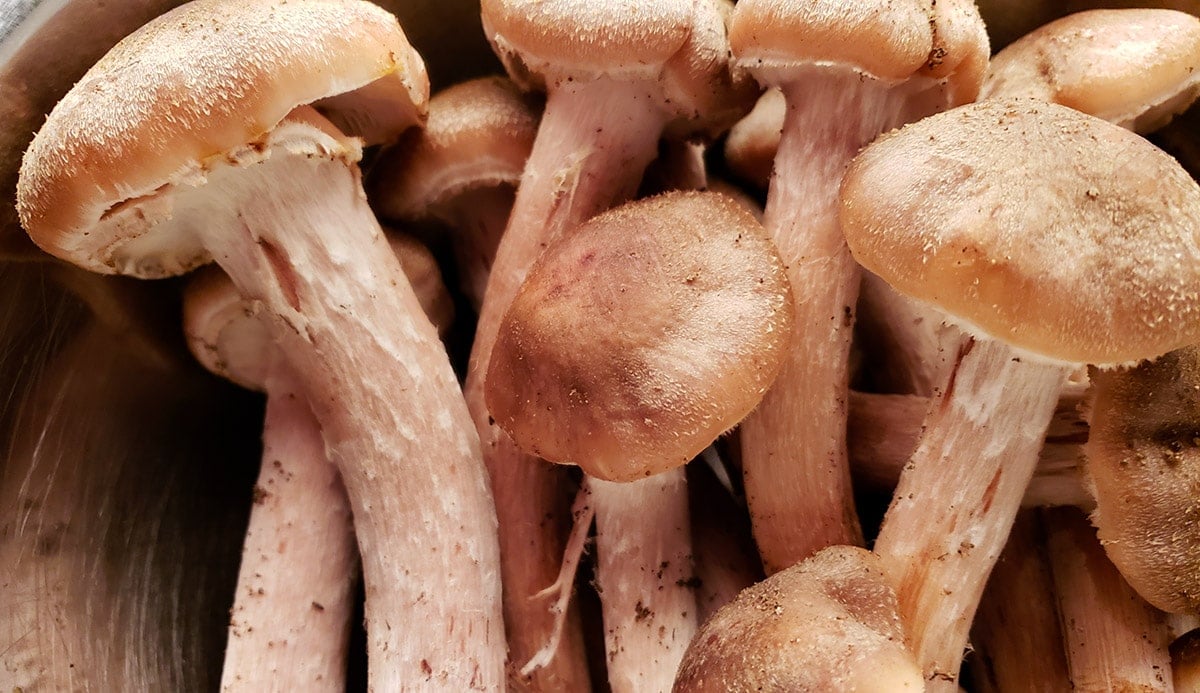
What makes a honey mushroom a honey mushroom? Lots of things, but there are two important markers to look for beyond three easy ones: where it’s growing, is it in a cluster and does it have the ring around the stalk? (Although there is a ringless honey mushroom, A. tabascens) The first important marker is whether the cap has five o’clock shadow:
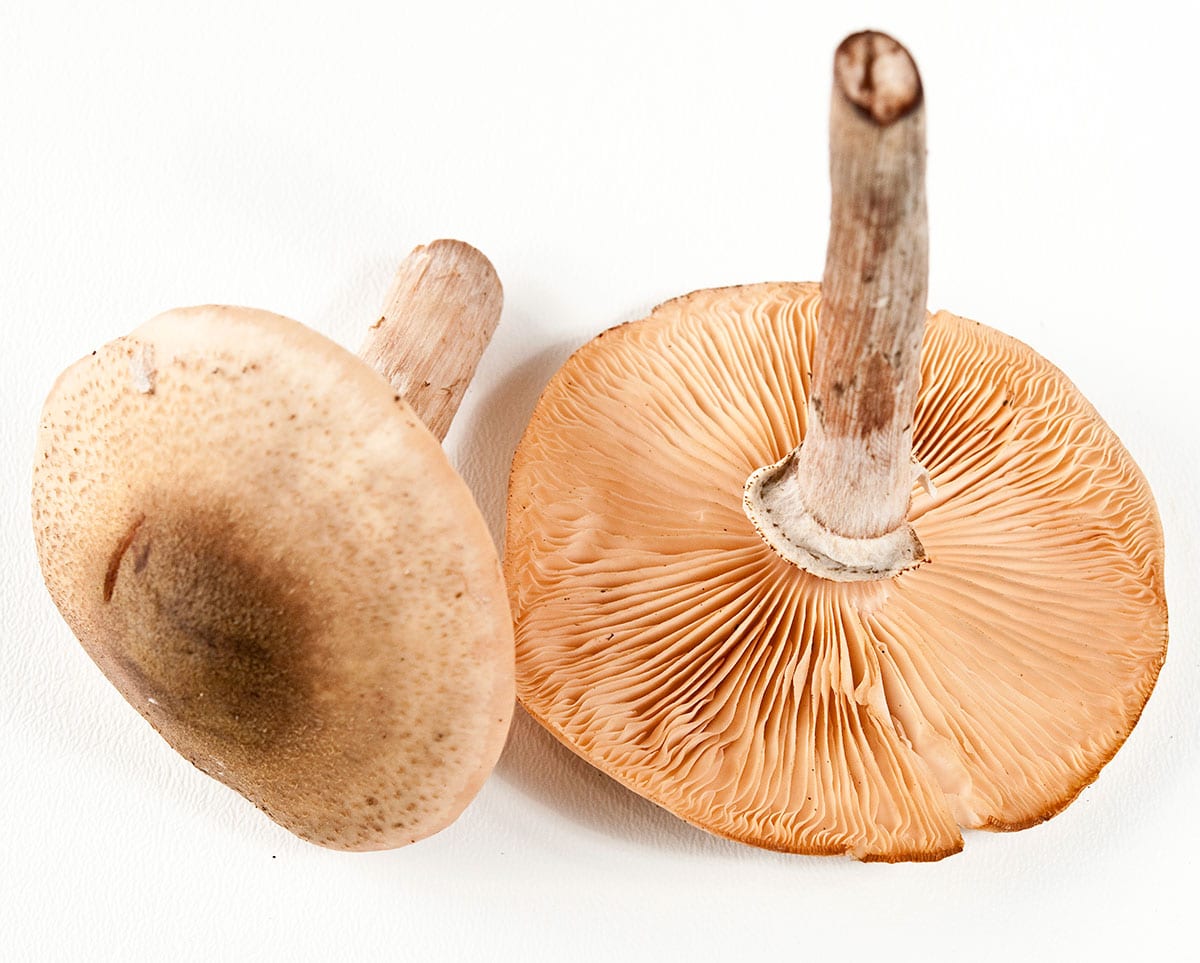
These little hairs, or speckly fuzzy things on the cap are a hallmark of a honey mushroom — which, incidentally, is so named for the range of colors it can have on the cap rather than its flavor. Look for these markings. You can see them even in the really young honey mushrooms in the top picture as pimply dots.
A second tell-tale marker is the mushroom’s gills: Honey mushroom gills are decurrent, meaning they run down the bottom of the cap and onto the top of the stalk, down to the mushroom’s faint ring.
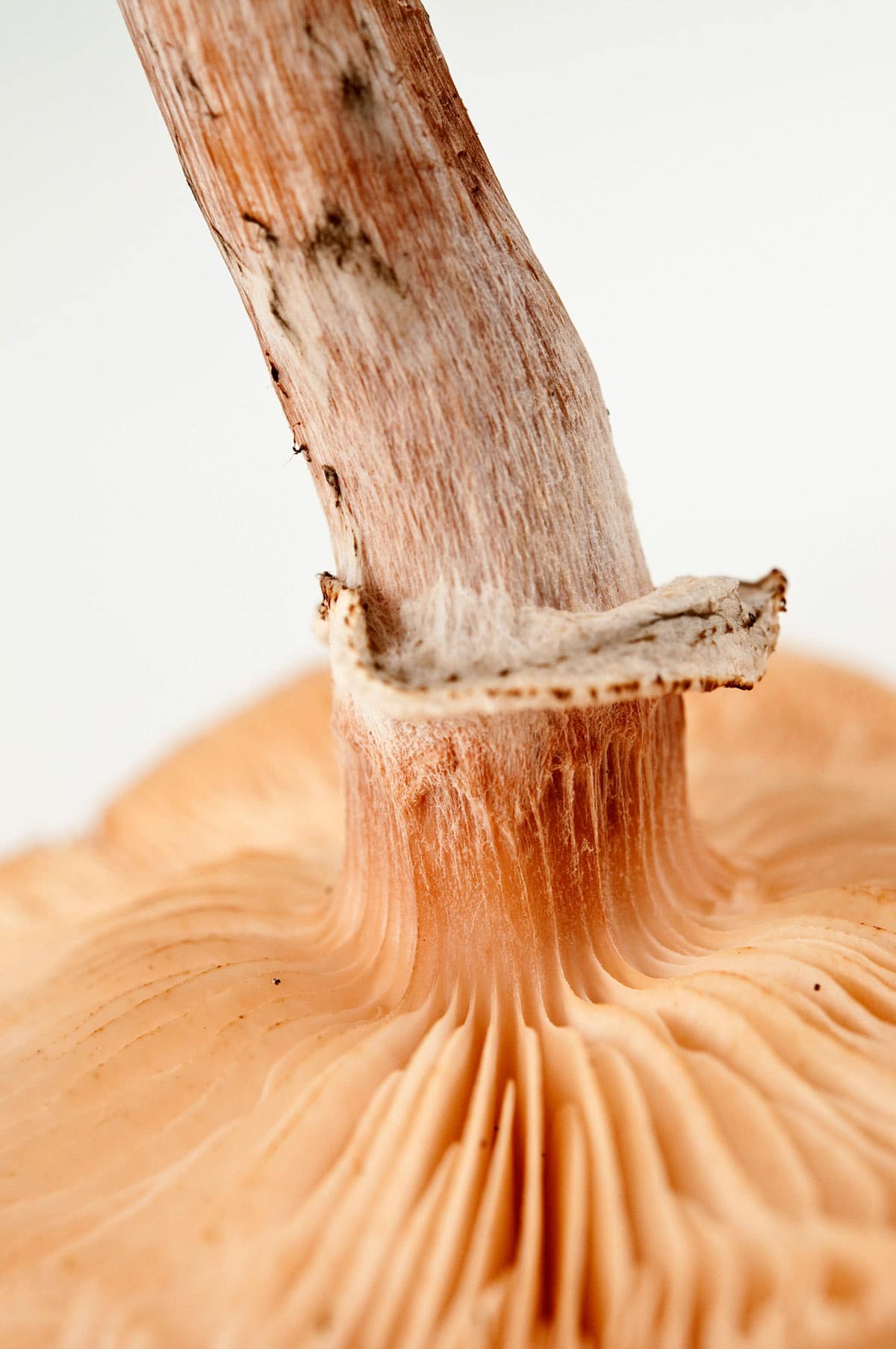
A final test is a spore print. It’s like a fingerprint for a mushroom, and will often confirm your best guesses after keying the thing out. To make a spore print, you slice off the stem of a mushroom and lay the cap, gills down, on paper. Ideally, you do a couple of prints: One on white paper, another on a darker paper. This is because a lot of mushrooms have white spores, which won’t show up on a piece of white paper.
Honey mushrooms have white spores.
Harvesting Honeys
Unless they are those pretty little buttons, you will want to collect only the caps of honey mushrooms. As the mushroom ages, the stalks get fibrous and not fun to eat — although they make a perfectly fine mushroom stock. Try to keep dirt out of the gills because they are a pain to clean.
Once gathered, set your honey mushrooms on paper towels in a lidded container in the fridge. They will keep this way for a week or so.
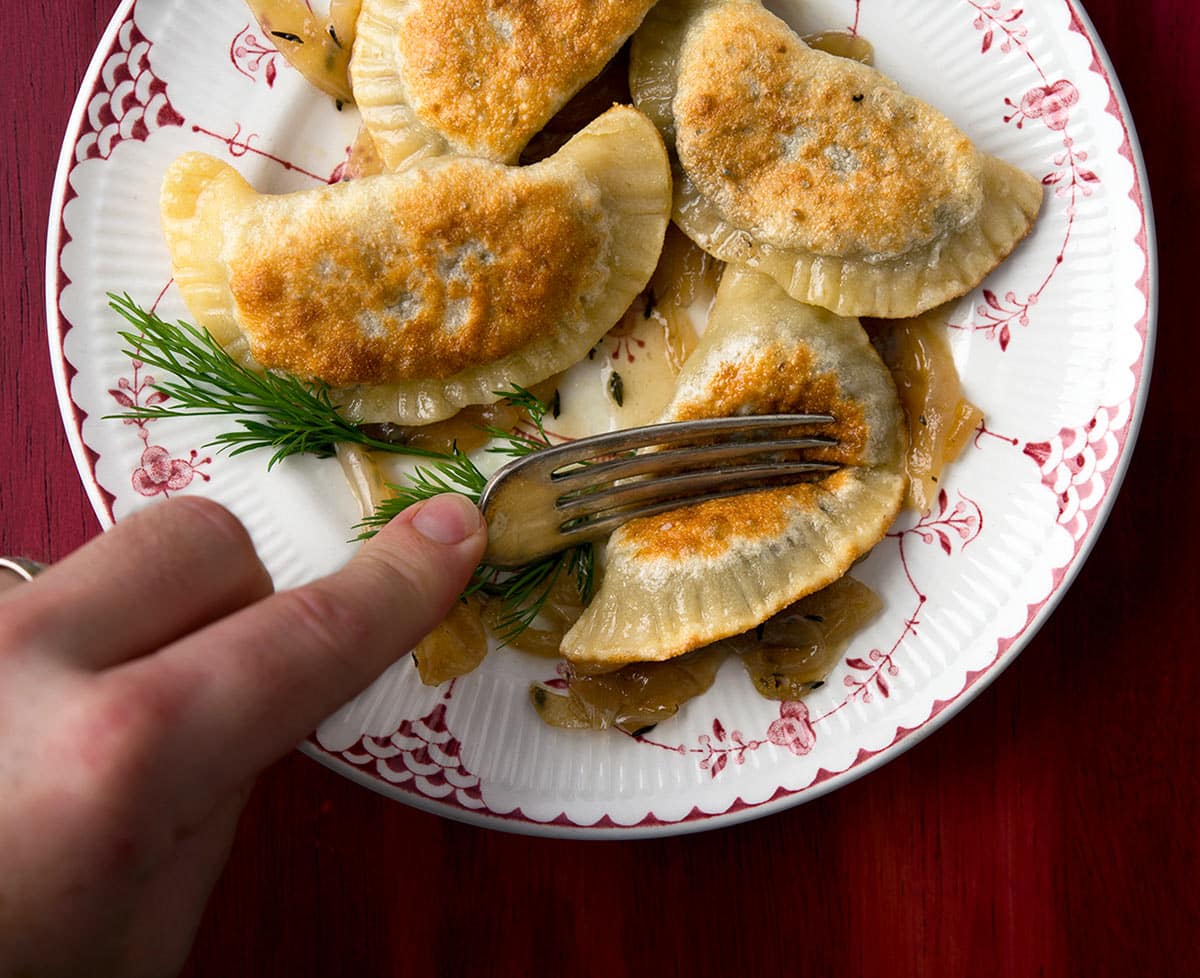
Cooking Honey Mushrooms
Before I start with this one, I need to tell you why you will never see a honey mushroom at the supermarket: It’s because a certain, measurable percentage of people who eat them, get a stomach upset. It’s not so much a toxin as it is an inability to digest them. It presents as a stomach ache and unhappy innards for a day or so.
So the first time you eat honey mushrooms, go easy. And wait a day.
Second caveat: Honey mushrooms must be thoroughly cooked. No quick sauté. Honeys need to be braised, stewed, or roasted for more than 1o minutes or so, and I always cook mine more than 30 minutes. An hour is better.
Third caveat: A honey mushroom is the mycological equivalent of okra, or nopales. Yeah I’m talking about slime. Honeys are not nearly as slimy as okra or nopales, but they are. This is why they are not terribly loved among most mushroom hunters: They are not a “fry it in butter and eat” sort of mushroom.
But this thickening effect is perfect when the mushrooms are part of a filling, or a stew.
Other good recipes for honey mushrooms include:
- Nothing beats using honeys as a filling for mushroom pierogi.
- Filling for bierocks, bready rolls stuffed with sauerkraut and other good things.
- Polish style salted and fermented mushrooms.
- A wild mushroom ragu or pasta sauce.
- You can mince the honey mushrooms and use them in place of morels in this sauce for venison or beef.
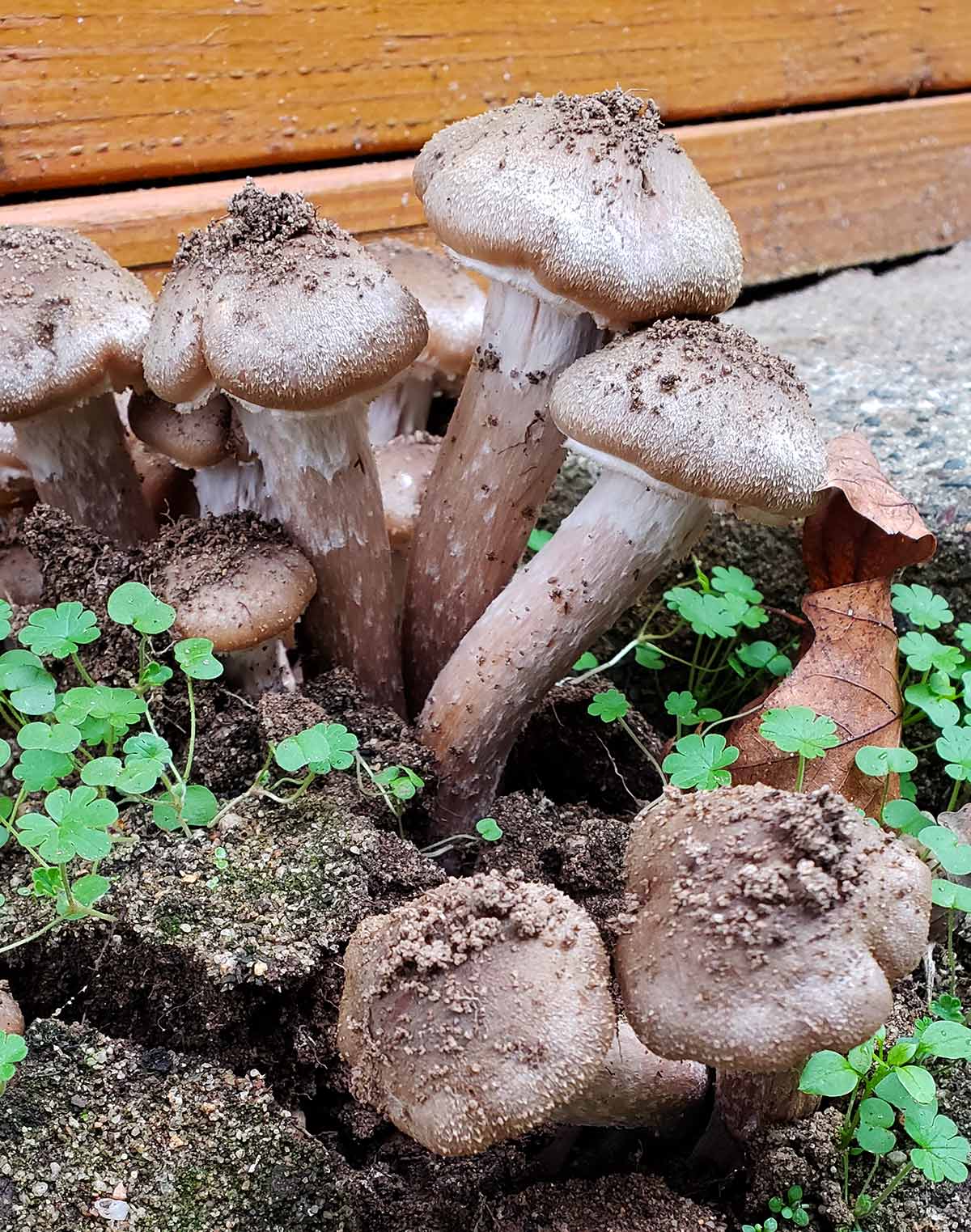
Preserving
I’ve tried pickling honey mushrooms, and, well, it was a slime fest. Not my thing. You absolutely can dehydrate them, and it’s a great way to preserve them for winter stews. That’s my go-to method. Just dehydrate at low temperature until the mushrooms get brittle and papery. It takes about 8 hours or so.
Another method is to cook, then freeze. This works well, too, but occupies freezer space, which is at a premium at my house. A good option for this is to pre-make a filling for, say, mushroom pierogis, or mushroom ravioli, and then vac-seal and freeze that.
In case you are wondering, yes, all this work is worth the effort. Too many foragers shy away from mushrooms because they are scary. And those who do typically stick with the traditionals — morels, porcini, chanterelles.
But scores of edible mushrooms live among us, and, if you are careful about identifying them, they can enrich your cooking in ways few other ingredients can. Many, like the honey mushroom, have special traits that you can take advantage of — if you know how to tap into them.
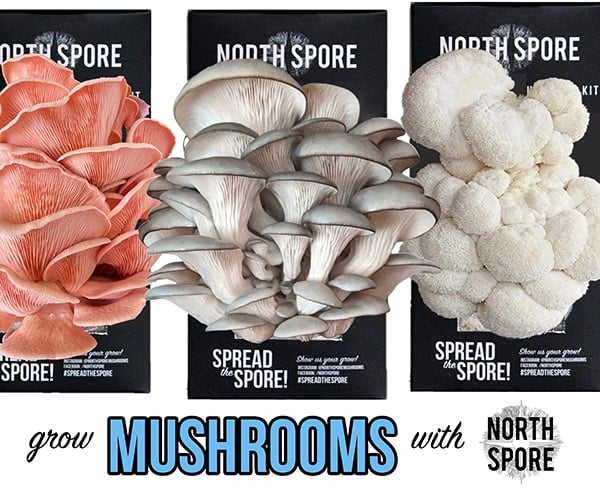




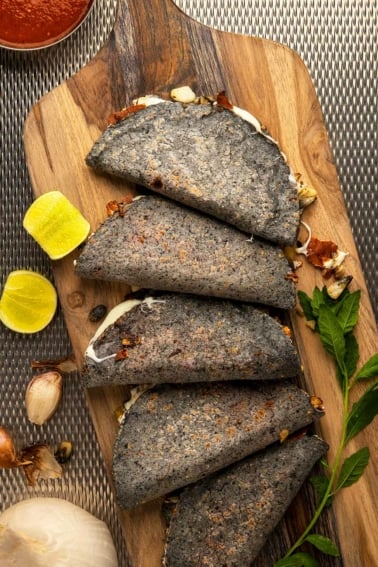

I found and collected both the Honey and the Fried Chicken this fall. I’d not been a big fan of either, thinking that they were both a little too bland to bother with.
But I decided that the problem might be with me rather than the mushrooms.
And so I decided to treat them as a source of umami in oriental styled soups.
Works!
Hank, I made these on Thursday from the dried ones and they did act as a thickening agent. I’m wondering if it’s because it’s fat soluble rather than water soluble because it thickens after adding the butter, but not when adding water. Turns out, however, that honey mushrooms and my stomach don’t get along. My husband is fine with them though. They were delicious though and I want to try this recipe with a different species.
Nice blewit pun.
I found a ton of honey mushrooms last summer, and traded them for a big chicken of the woods. It was pretty hot, though, so not much else fruited; my black trumpet spot was sadly deficient.
Jessa: Just say no to snobbery – we see it with duck hunters, too. “Oh, this duck is no good.” Depends on what you do with it…
Brent: Very cool! I may just come back to Manitoba for those walleye – I hear it is a spectacular fishery. On the honey mushrooms, are they still slimy after pickling? Do you cook them before pickling?
JR Young: Sadly, I have not yet found a really good chanterelle spot. Wah. Still searching…
Cork: Thanks! I was hoping to put enough info in here to help others actually key out the mushroom. Too many people say, “well, don’t take my word for it, check a guidebook.” Good enough advice, but if you don’t even know where to begin with a guidebook, you can get lost in a hurry.
bpaul: Still have not yet found a patch of fried chicken mushrooms yet…
Ken: I’ll take you out in February, if you want!
Carol: I hear that! I am always the guinea pig when I bring a new mushroom home. Test, eat a little, wait. THEN serve to the girlfriend….
Rachel: Interesting. No thickening? Wonder if the drying process removes that from the mushroom? I have some dried now, and will test them out.
Ansel: Yeah, honeys are a weird lot, biologically. There are reports that they have slightly different textures and flavors depending on host, although most say they are a little slimy when cooked fresh – I know mine were!
Doris: Go for it! Buy a good guidebook like David Arora’s and try to add a new mushroom to your knowledge every trip, whether it’s edible or not.
I’m cautious about my mushrooms. But I swear I’ve seen those before, and they do look edible. Good on you for doing the leg work and eating them. Also, wonderful post for the clear pictures of the gills etc. really helpful. Too snowy in MN right now for any mushrooms, next year.
Wonderful post! Thanks for all the details on spotting a safe mushroom. Very helpful.
Happy New Year!!
You are my hero, Hank. I come from morel country but have yet to venture out into East Coast mushrooming, in part because morels are the only ones I know. Maybe this year will be the spring I start to explore the Pennsylvania hinterlands….
Honey Mushrooms are actually a species complex and different specimens can vary quite a bit. I have collected them on the east coast and interestingly, did not find them slimy at all. Maybe a different part of the species complex? The ones that I found had a deep umami flavor which was quite distinctive. Maybe the host species affects the flavor?
As I mentioned, we dried ours. Last night I reconstituted them in a skillet with some water and added them to a turkey vegetable soup. They didn’t thicken anything up, including the water I used to reconstitute them. I’ll have to tweak your recipe for these dried ones.
Excellent post as usual, Hank! I should show it to my husband. He’s very cautious about the mushrooms I bring home from a foray and resists any that “look dangerous”–i.e., with gills and a central stalk. Oyster mushrooms? Fine. Chanterelles? Yippee! Honey mushrooms? Nope, no way. I found a cluster of armillaria mellea last year–a real find, as there aren’t that many edible mushroom species in L.A.–and DH wouldn’t hear of eating them. I sat him down with Arora’s book and painstakingly went through the keying process with him. Hey, I even got the correct ID! And what did my beloved say? “If it’s that much trouble to identify them, I don’t want us to take the risk!” and he made me promise not to eat any. So into the compost heap they went, deep sigh. And I’d have been willing to eat some secretively, except that if I’d been one of the unfortunates with a GI sensitivity, I would never have heard the end of it! The things we do for marital harmony…
They’re quite beautiful – the shrooms and tis the season for piroshki! Now if I only knew how to forage! Ken
Also, Fried Chicken Mushrooms are one of the few wild mushrooms I’ve definitely shown a sensitivity to. A shame, because I run into them on a pretty regular basis. And, I enjoy the sound of their Latin name.
Bp
Fantastic post. Excellent keying photographs.
I like honey mushrooms, and boy howdy can they be prolific in the right circumstances. Often, up here, the right circumstances turn out to be an area that has recently been selectively logged. The forest is generally full of small trees and ground debris, and feels like it is under a bit of pressure. Often, honeys will explode over such a landscape.
Interestingly, I’ve never had the sliminess happen when I cooked them. I’ll file them under “good for drying and soups” then.
Your Northern Fan,
Bp
Great description of the ID/keying process. Those pierogis look delicious!
Nicely written and edifying, Hank: felt like I was in a worthwhile mushroom hunting field course!
We have chanterelles coming in by the bucket load right now. We were out again today looking for some king boletes but had no luck. We found many slippery jacks and a matte jack which we have not found before.
I like the winter mushrooms, but I can’t wait until spring to chase morels in the Sierra and in WA.
Hank – you always make me hungry – these mushrooms you refer to are a comfort food for those of use here in Manitoba of Ukrainian heritage. We call them ‘pidpenki’ – a fall time treasure – here in abundace after the first fall frosts – then picked, preserved (either frozen or canned) and then served at our traditional Ukrainian Christmas eve dinner – 12 meatless dishes and the pidpenki (slimy as they are) are one of the awaited for treasures – served in a cream sauce. Keep up the great writing. And – if you want to return to Manitoba for an adventure other than waterfowl hunting – let me know – and we can treat you to and incredible march ice-fishing adventure – and some of our famed lake Winnipeg walleye – a treat worth driving from California for!
Oh wow- mushrooms and filled dumplings in the same post!
My husband’s coworker recently gave us 15lbs of honey mushrooms he had found. He picked a couple and I went through the task of IDing them like you did. Once I confirmed what they were he picked the rest and delivered them to us. We did a quick dry sautee on a couple of them to try and then dehydrated the rest. I’m glad to know how the cook and now what to do with them. Thanks for the recipe!
I’ve been turned away from these many a time by snobby mycologist friends.
Last time, I actually picked them and then was told to throw them out by the guy we were out with…because they were “not worth it”. Seems silly, since they are so plentiful and easy to pick (unlike the slither-around-in-the-mud-looking-for-mud-colored-holes black chantarelle, which is a b*tch to find).
Now I know better. AND I know where there’s usually a GIANT patch of ’em right here in town!